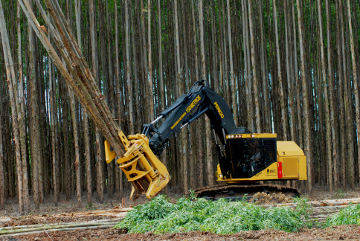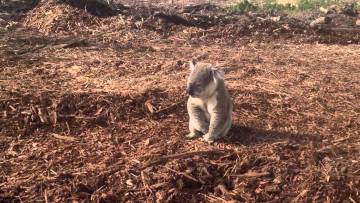Forest Loss
Accelerated by fossil fuels
We can’t know precisely how much forest has been degraded or destroyed since humans began using fossil fuels, but there’s no doubt that the areas are huge. In the last 8000 years, humans have completely removed half of global forest cover and degraded another 30%, meaning the planet has lost 80% of primary old growth.1
For thousands of years, agricultural societies damaged their landbases through deforestation. But the rise of industrialism increased the destruction fourfold, and made it global in scope. Chainsaws to feller bunchers to Gyro-Tracs allow for faster and more thorough deforestation. More significantly, fossil fuels enable transportion of logs to the global market, leaving no forest beyond reach of exploitation for profit.
Climate disruption multiplies the numbers and intensity of disturbance-causing natural disasters such as hurricanes and fires. Increased heat and drought stresses forests, killing trees outright or making them more vulnerable to insects.

Historic global net forest loss
| Period | Annual loss (millions of acres) 2 |
|---|---|
| 1700 - 1849 | 4.76 |
| 1850 - 1919 | 7.23 |
| 1920 - 1949 | 27.5 |
| 1950 - 1979 | 27.66 |
| 1980 - 1995 | 34.89 |
Contemporary loss
The Food and Agriculture Organization of the UN (FAO) estimates 16 million acres of natural forest lost globally from 2010 - 2015. That’s one acre every two seconds.
Global Forest Watch uses satellite imagery to estimate global tree cover loss at 42-73 million acres per year from 2011-2016. That’s 1.3 to 2.3 acres of cover lost every second.
See below regarding challenges interpreting deforestation data from different sources. But every source agrees that the decline is precipitous.
Consequences
Trees play critical roles in the web of life. The loss of trees, especially those in primary old growth forests, degrades and disrupts topsoil, air quality, carbon sequestration, net primary productivity, habitat, and water quality and availability.
The destruction of forests devastates the lives of all who call them home. Uncounted non-humans depend entirely on forests, dying off and even going extinct when their habitat is taken away. All humans rely on forests for the global cycling of water, air, and carbon; and more than a billion more are directly sustained by food, fuel, shelter, and fodder from forests.
Challenges interpreting data
Hundreds of definitions of “forest” make it difficult to compare data from different countries or sources. The two main attempts at global measurements come from the Food and Agriculture Organization of the United Nations and from World Resources Institute. Their data is complementary, giving two different perspectives:
Food and Agriculture Organization (FAO)
FAO releases Global Forest Resource Assessments (FRA) every five years. They use an internally consistent definition of “forest,” but rely largely on self-reporting by countries, so data gathering isn’t necessarily homogenous or entirely accurate.
Actual tree cover doesn’t matter in the FAO definition of forests, so long as a land has the potential to grow trees of the necessary size, and so long as land is intended for forest growth. An area which is clearcut or devastated by insects or by fire still counts as forest. Tree plantations for food products are excluded.
In their global statistics, FAO distinguishes between natural vs planted forest. Their definitions do distinguish between “primary forest,” “modified natural forest,” and “semi-natural forest,” but their data doesn’t have that much granularity, distinguishing only between “natural” and “planted” forests. Since “natural” can include secondary regrowth or areas reforested by humans, it’s impossible to deduce how much old growth is lost.
See Rainforest Foundation’s “Irrational Numbers: Why the FAO’s Forest Assessments Are Misleading” for further critique.
World Resources Institute (WRI)
WRI teamed with other organizations to launch Global Forest Watch in 2001. This data set tracks tree cover without attempting to characterize the land use. Areas recently clearcut are not counted as forest, but monocrop plantations are.
In its 1997 report The Last Frontier Forests: Ecosystems & Economies on the Edge, World Resources Institute estimated global forest cover of 62.203 million square kilometers 8000 years ago. The 1996 The World Forest Map by The World Conservation Monitoring Centre estimated 33.363 million square km of cover remaining, of which only 13.501 million square km were primary forest.
WRI measures forest cover gain, loss, and total cover, but warns that:
Due to variation in research methodology and/or date of content, tree cover, loss and gain cannot be compared against each other. Accordingly, “net” loss cannot be calculated by subtracting tree cover gain from tree cover loss, and current (or post-2000) tree cover extent cannot be determined by subtracting annual tree cover loss from year 2000 tree cover extent.
It’s unclear how to assemble their data into a unified big picture, but the rapid decline in tree cover is obvious.
-
World Resources Institute, The Last Frontier Forests: Ecosystems & Economies on the Edge, p 14. Their data from 1997 estimated 46% loss of forest cover, and 78% loss of old growth. ↩︎
-
Michael Williams, Deforesting the Earth, p 372. His sources are J. F. Richards, “Land Transformation,” in The Earth as Transformed by Human Action, ed. B. L. Turner II et al. (Cambridge: Cambridge University Press, 1990), 164; and amendments by M. Williams, “Forest and Tree Cover,” in Changes in Land Use and Land Cover: A Global Perspective, ed. W. B. Meyer and B. L. Turner II (Cambridge: Cambridge University Press, 1994), 97124. ↩︎
Consider supporting our work by joining our mailing list below, sharing & "liking" this page, and following us on social media. You may freely republish this Creative Commons licensed article with attribution and a link to the original.

